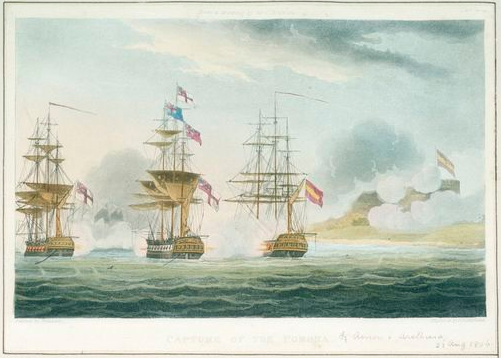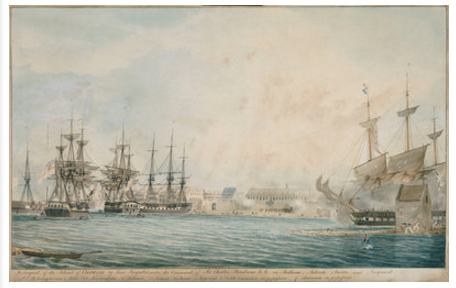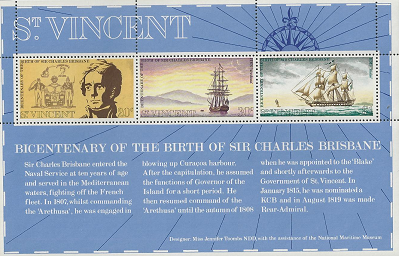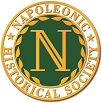Sir Charles Brisbane – From the Same Cloth as Nelson
by Hank Zucker, NHS Pres. Emeritus , FINS Membre d’Honneur

So reads a recruiting poster for an 1805 cruise led by Capt. Charles Brisbane. On that cruise Brisbane and his crew would find glory and very nearly get those Spanish dollars. Brisbane would be honored and knighted and become governor first of Curacao and then St. Vincent.
Brisbane was one of the most daring and successful frigate captains of the Age of Nelson. He was the son of an RN captain and entered naval service at age 10. Two years later as a midshipman on the ship of the line Hercules, 74 he participated in Admiral Rodney’s great victory over de Grasse at the Battle of Les Saintes. During the battle young Brisbane was seriously wounded in the back and taken below. Showing the mettle he would display throughout his career, he returned to duty after the wound was dressed. His captain was much impressed at the courage and determination of this 12-year old and later helped him get his lieutenant’s commission.
Brisbane spent the next 5 years in a series of ships patrolling the Irish and Baltic Seas. At 17 was promoted acting lieutenant on a sail to Halifax, but was not confirmed when he got back to England. He was finally commissioned in 1790, while serving on the Brunswick, commanded by Sir Hyde Parker, to whom Lord Nelson would later turn a blind eye at Copenhagen.
Lieutenant Brisbane then headed to the Mediterranean on the frigate Meleager and participated in the attack and subsequent defense of Toulon. During the latter he was given command of Fort Pomet, one of the most dangerous outposts. When Napoleon’s efforts forced the British to evacuate Toulon, Brisbane was ordered to retreat. While French troops “were pouring down in considerable force and were within the distance of two musket shots,” he stopped to set fire to a trail of gunpowder that led to 500 barrels. The explosion “blew the fort to atoms,” and Brisbane and his men made it back to the main British lines without loss.
Following the evacuation of Toulon Brisbane fought in Corsica under the command of Nelson. Brisbane acquired an unfortunate similarity to Nelson when an enemy shot hit a gun next to him and sent several pieces of iron into his head. He was removed to a ship, where a cure was affected, but it left him almost blind in one eye.
Brisbane returned to duty six weeks later and conjured a plan to burn five French ships of the line. He was given command of the Tarleton, a captured 14 gunner rigged as a fire ship. The French ships left the harbor before the plan could be put in place, but Lord Hood admired the plan enough to advance Brisbane to the rank of commander and left him in command of the little ship.
Then under the command of Lord Hotham, Brisbane and Tarleton and spent time on blockade duty. The he was then given command of a small squadron to protect shipping between Basita and Livorno, Italy and was present at Hotham’s action against the French fleet in March 14, 1795.
Soon after that action Commander Brisbane was given the Mozelle and sent to Gibraltar. There he was ordered to convoy two troop ships to Barbados. Along the way he encountered a Dutch squadron and decided it was more important to ascertain where they were going than to continue guarding the troop ships. He shadowed the Dutch until he determined they were headed for the Cape of Good Hope. He raced ahead of them to apprise Lord Keith of the situation. Keith’s squadron captured the Dutch, and Keith was so pleased with Brisbane that he made him a post captain.
Captain Brisbane was given command of the l‘Oiseau of 36 guns and sent to cruise off the Rio de la Plata. While there Brisbane got into a fight with two Spanish 38 gun frigates. Through extraordinary seamanship and a well-trained creww, Brisbane with 36 12 pounders managed to beat off the two ships which each had 38 18 pounders!
News of the general mutiny of 1797 reached Brisbane’s ship at St. Helena. The crew rose against their officers. Sensing the moment called for decisive action, Brisbane seized one of the ringleaders, put a halter around his neck and threatened to kill him if the crew did not return to their duty. The leader and crew were so shocked, that return to duty they did.
Captain Brisbane spent the next few years guarding convoys, blockading France and patrolling the Atlantic and Caribbean. In 1803 he was in command of the 74-gun ship of the line Goliath on blockade duty off the French coast. At one point he was caught near the coast by a violent gale. Concerned that the ship might be forced onto some rocks, the ever-audacious Brisbane sought shelter in a French port (!), just outside of the range of batteries guarding the harbor. When the weather eased he was able to get out to sea again before the French could stop him.
In 1805 Captain Brisbane was appointed to the Arethusa, 38 and sent with a convoy to Jamaica. After delivering the convoy he was sent to cruise off Havana, Cuba. His ship ran aground in a small group of little islands rocks called the Colorados. He had to order all the ship’s guns thrown overboard to lighten her enough to be pulled off. On his way back to Jamaica he encountered a Spanish ship of the line. A ship of the line was normally far more than a match for a frigate, let alone a frigate with no guns. So confident was Brisbane in his men, though, that he immediately called them all on deck and told them he wanted to catch the Spanish ship and take her by boarding! “Three cheers, from every man upon deck, was all the answer that these brave fellows gave to their captain.” They set all possible sail, but the Spaniard ran (!) and made it to the protection of a fort before the Arethusa could catch her.
In August 1806, after rearming his ship in Jamaica, Brisbane set out to once again patrol the waters off Havana. This time he also had the frigate Anson, 44 commanded by Captain Lydiard, under his command. They found the Spanish frigate Pomona not far from the coast. While Brisbane and his crew couldn’t know it, she had the gold his poster had promised.
 The Pomona ran for the protection of a fort that had about 15 36-pounders, and 12 gunboats came out from Havanna to aid her. Despite this formidable defense, Brisbane anchored the Arethusa near the Pomona in water only a foot deeper than his ship drew. He then pounded the Pomona, while the Anson dealt with the gunboats. The Pomona surrendered after 35 minutes, but sadly that was time enough to land her gold ashore. Three of the gunboats were driven ashore, three sunk and six blown up. Despite red-hot shot from the castle that set Arethusa temporarily on fire, some of Brisbane’s men took possession of the Pomona and sailed her away. She was later purchased into the British fleet as the Cuba.
The Pomona ran for the protection of a fort that had about 15 36-pounders, and 12 gunboats came out from Havanna to aid her. Despite this formidable defense, Brisbane anchored the Arethusa near the Pomona in water only a foot deeper than his ship drew. He then pounded the Pomona, while the Anson dealt with the gunboats. The Pomona surrendered after 35 minutes, but sadly that was time enough to land her gold ashore. Three of the gunboats were driven ashore, three sunk and six blown up. Despite red-hot shot from the castle that set Arethusa temporarily on fire, some of Brisbane’s men took possession of the Pomona and sailed her away. She was later purchased into the British fleet as the Cuba.
During the action Brisbane was wounded in the knee, but despite the excruciating pain, he remained on deck until he saw the British flag hoisted on the Pomona. The Arethusa’s total losses were two killed and 32 wounded. Vice-admiral Dacres, commanding in Jamaica, proclaimed that “the success attending this bold enterprise, Captian Brisbane was well entitled to, for the promptness and decision with which he anchored in such shoal water, to attack a force of such magnitude”
News of this success was celebrated when it reached London. The Patriotic Fund at Lloyds awarded Captain Brisbane one of their famous swords.
Like many other captains of the time, Brisbane had a hobby. Fortunately for us, his was painting, and the National Maritime Museum has two watercolors he made of this action. Colored engravings based on his paintings of the capture of the Pomona were published.
Later in 1806 Admiral Dacres sent Captain Brisbane with the Anson and another frigate the Latona, 38 to reconnoiter the Dutch island of Curacao and see if the inhabitants could be persuaded to submit to British rule. This was not the first British attempt to capture Curacao. In 1804 Captain John Bligh led a substantially larger force of two ships of the line, two frigates and a sloop in an attempt to take the island. He thought Willemstad, the main town and harbor, too well-defended to attack directly. So he landed marines, sailors and guns and traded shots with the Dutch forts. They captured a couple of smaller outer ones, but were unable to take either Fort Amsterdam or Fort Republiek, the most formidable fortresses guarding the harbor. The British withdrew after a few weeks.
On December 23 the frigate Fisgard joined the squadron off Aruba. Captain Brisbane decided he was not just going to reconnoiter the situation, but formed a plan to take it by coup de main. He called the other captains together and told them of his plan to attack Curacao on New Year’s Day.
 The entrance to Willemstad’s harbor was a narrow channel only wide enough for one ship at a time, with forts and batteries on both sides. The harbor opened wider at the end of the channel. Fort Republiek was situated so that it commanded the whole port. In the harbor were the 36-gun Dutch Frigate Kenau Hasselaar, the 22-gun Surinam and.two armed schooners.
The entrance to Willemstad’s harbor was a narrow channel only wide enough for one ship at a time, with forts and batteries on both sides. The harbor opened wider at the end of the channel. Fort Republiek was situated so that it commanded the whole port. In the harbor were the 36-gun Dutch Frigate Kenau Hasselaar, the 22-gun Surinam and.two armed schooners.
Brisbane put on his dress uniform to encourage the men, and when they beat to quarters he found his men had taken it upon themselves to chalk “Victory or Death” on their caps. The ships formed up one behind the other and followed the Arethusa into through the channel and into the port.
Captain Lydiard of the said the enemy were “panic-struck” at the squadron so unexpectedly sailing down the channel. The word of an attacker so characterizing his foes may be suspect, but it is clear the Dutch did not use their superior position to anything near its full advantage.
The frigate, sloop and schooners were taken by boarding. Brisbane, like Nelson at St. Vincent, personally led the assault. He was the first onto the Kenau Hasselaar and pulled down her colors. Then with about two dozen men he assaulted Fort Amsterdam. Still at the front, he was the first up the ladder and pulled down the fort’s flag. This success was extraordinary, considering the fort was defended by 275 soldier!
Once in possession of the fort, Brisbane told the Dutch governor he had 5 minutes to surrender. The governor said that half an hour was needed to save his honor and his head. Brisbane let him have the time. Then the Dutch surrendered.
By 10:00 the British flag was hoisted over Fort Republiek, and the island, which had been defended by 1200 militia, besides the regulars, was in British hands, taken by 800 men. Amazingly, the British lost only three dead and 14 wounded!
 Since the Dutch governor refused to take an oath of loyalty to King George, Captain Brisbane took over the governorship of the island. Vice admiral Dacres was extremely impressed with this victory, one of the most astonishing of the Revolutionary and Napoleonic Wars. He recommended that Captain Brisbane be confirmed as governor, but the crown had other ideas. They gave the governorship of Curacao to another, but they knighted Captain Brisbane and in 1808 made Sir Charles governor of St. Vincent, a post he kept until his death in 1829. He served longer in that post than any other governor or head of state of St. Vincent before or since.
Since the Dutch governor refused to take an oath of loyalty to King George, Captain Brisbane took over the governorship of the island. Vice admiral Dacres was extremely impressed with this victory, one of the most astonishing of the Revolutionary and Napoleonic Wars. He recommended that Captain Brisbane be confirmed as governor, but the crown had other ideas. They gave the governorship of Curacao to another, but they knighted Captain Brisbane and in 1808 made Sir Charles governor of St. Vincent, a post he kept until his death in 1829. He served longer in that post than any other governor or head of state of St. Vincent before or since.
